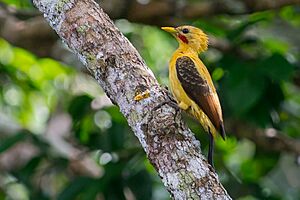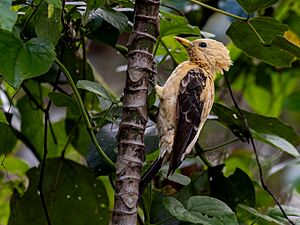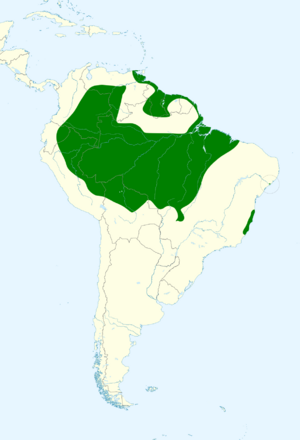Cream-colored woodpecker facts for kids
Quick facts for kids Cream-colored woodpecker |
|
|---|---|
 |
|
| male at Manú National Park, Madre de Dios, Peru | |
 |
|
| A female at Santana, Amapá, Brazil | |
| Conservation status | |
| Scientific classification | |
| Genus: |
Celeus
|
| Species: |
flavus
|
 |
|
| Synonyms | |
|
Crocomorphus flavus |
|
The cream-colored woodpecker (Celeus flavus) is a beautiful bird from the woodpecker family. You can find it in many countries across South America. It lives in places like Brazil, Peru, Colombia, and Venezuela. This woodpecker is easy to spot with its yellowish feathers and a long crest on its head!
Meet the Cream-Colored Woodpecker!
What Makes This Woodpecker Special?
The cream-colored woodpecker is about 24 to 27 centimeters (9 to 11 inches) long. That's about the length of a ruler! Its weight can vary a lot, from about 95 grams (3.4 ounces) to 200 grams (7 ounces).
Most of these woodpeckers are a lovely yellowish color. This color can be light creamy yellow or even a bright sulfur-yellow. They all have a long crest on their head and a black tail.
Spotting the Difference: Males and Females
It's easy to tell the difference between male and female cream-colored woodpeckers.
- Adult males have a bright red stripe on their cheek.
- Females do not have any red on their face.
Their beak is yellowish, and their eyes are red or reddish-brown. Their legs are dark gray to green-gray. Young woodpeckers look a lot like the adults, but they might be a bit more buff or cinnamon-colored.
Different Types of Cream-Colored Woodpeckers
Scientists group animals into different types, called subspecies. For the cream-colored woodpecker, there are a few different ideas about how many subspecies exist. Some scientists say there are two main types, while others say there are four.
These types look very similar, but they have small differences. These differences are mostly in their size and the color of their wings. For example, some might have more brown or rufous (reddish-brown) colors on their flight feathers.
Where Do They Live?
The cream-colored woodpecker lives in many parts of South America. You can find them in:
- Eastern Colombia
- Parts of Venezuela
- The Guianas (Guyana, Suriname, French Guiana)
- Northeastern and western Brazil
- Eastern Ecuador
- Northern Bolivia
- Eastern Peru
Their Favorite Homes
These woodpeckers love to live in humid forests, especially near water. They can be found inside thick rainforests or at the edges. They also live in swampy forests and forests that flood (called várzea).
Sometimes, you might see them in other places too. These include:
- Forests along rivers (gallery forest)
- Mangrove swamps
- Open woodlands
- Forests that are growing back after being cut down (secondary forest)
They can even live in places changed by humans, like cacao farms! They usually live in low areas, below 400 meters (about 1,300 feet) high. But sometimes, they can be found up to 700 meters (about 2,300 feet) high.
How They Live: Behavior
Staying Put
The cream-colored woodpecker is a "resident" bird. This means it stays in the same area all year long. It doesn't migrate (travel) to different places for different seasons.
What's on the Menu?
These woodpeckers love to eat ants and termites! They also enjoy eating fruits and seeds. They usually look for food in the lower and middle parts of the forest. But sometimes, they will search for food high up in the trees or even on the ground.
They are very clever at finding their favorite snacks. They often break into the nests of ants and termites that are built in trees. They usually feed in pairs or small groups.
Family Life
Scientists are still learning about when and how cream-colored woodpeckers raise their young. It seems their breeding season changes depending on where they live. For example, they might nest between April and June in Colombia. In Suriname, the season might start as early as February. We don't know much else about their breeding habits yet.
Their Calls and Sounds
The cream-colored woodpecker makes some interesting sounds! One of its calls sounds like a high-pitched laugh, like "wutchuk kee-hoo-hoo-hoo." Some people describe it as "pueer, pueer, purr, paw."
They also make other calls, such as "kiu-kiu-kiu-kiu." When they meet other woodpeckers, they might use a sound like "whéejah," which they can repeat.
How Are They Doing?
The IUCN (International Union for Conservation of Nature) has looked at the cream-colored woodpecker's situation. They have assessed it as "Least Concern." This means that, for now, it's not considered to be in immediate danger of disappearing.
Even though it has a very large area where it lives, we don't know exactly how many cream-colored woodpeckers there are. Scientists believe their numbers might be slowly going down. Luckily, no big threats have been found for them right now. While they are generally "rather uncommon," they are very common in Venezuela. They also live in several protected areas, which helps keep them safe.


